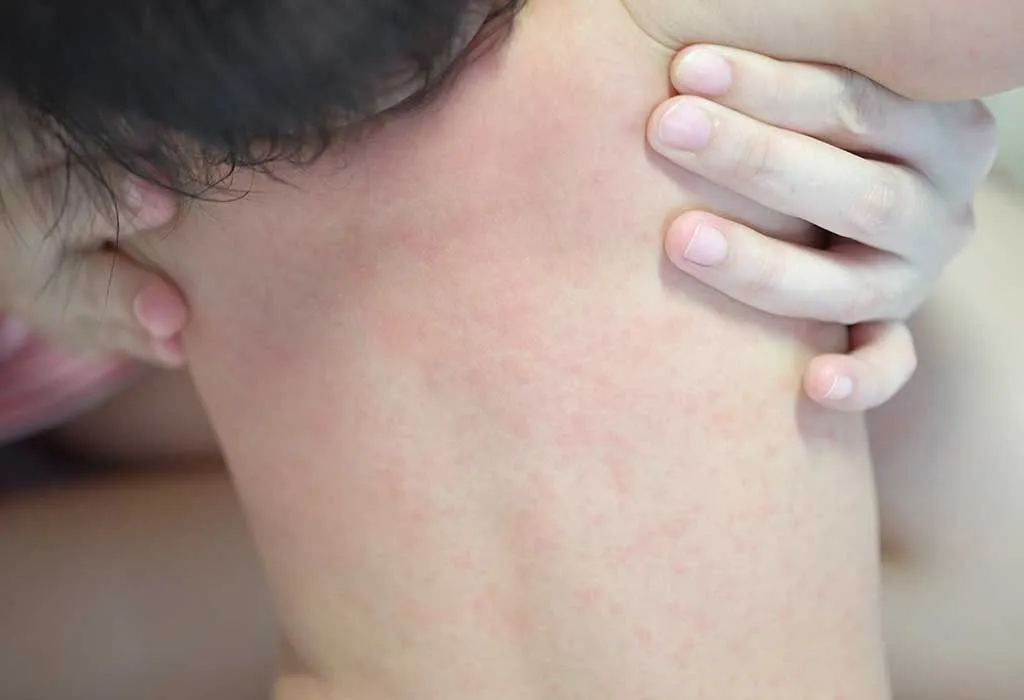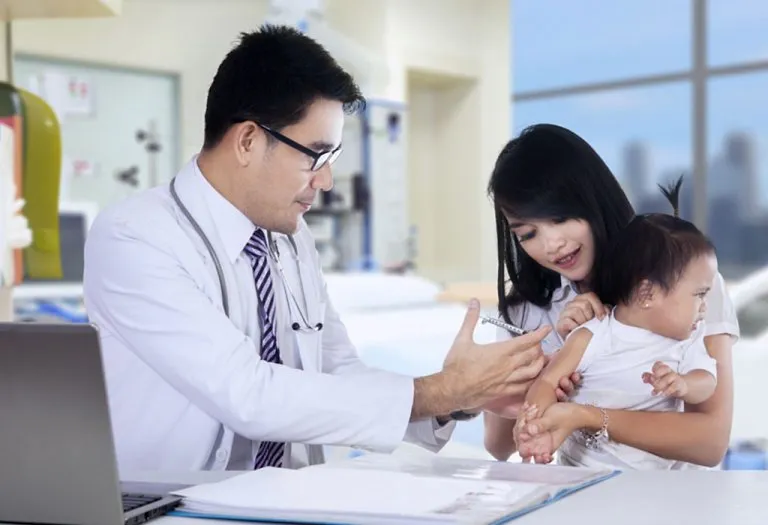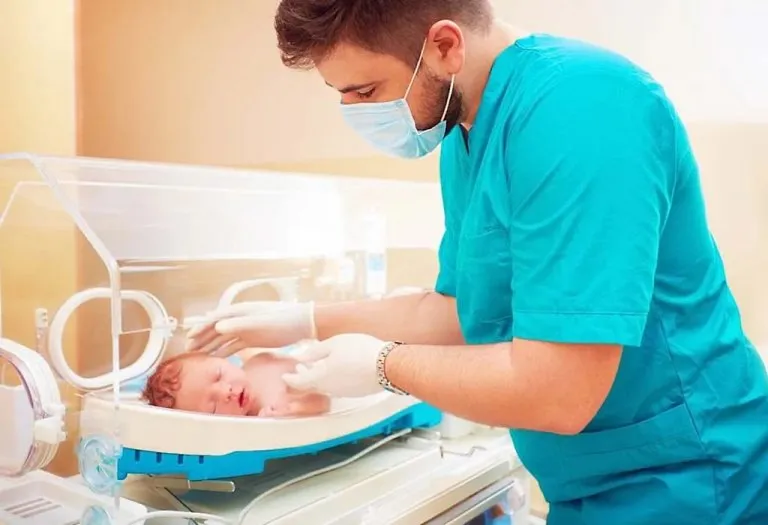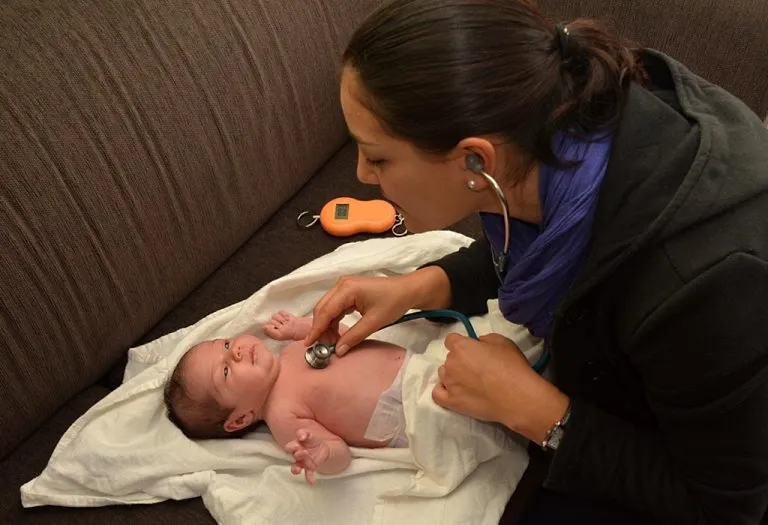Blood Infection or Sepsis in Children – Causes, Signs and Treatment
- What is Blood Infection in Children?
- Causes of Blood Infection in Children
- Signs and Symptoms of Blood Poisoning
- Diagnosis of the Blood Infection in Kids
- Treatment of Blood Infection
- Risks and Complications of Blood Infection
- Home Remedies for Blood Infection
- How to Prevent Blood Infection in Children?
- When to Consult the Doctor?
- FAQs

Diagnosis of the Blood Infection in Kids
Since the symptoms or signs of blood infection in children are not transparent or definite, doctors order lab tests to confirm or rule out blood infection in children. The doctor first looks for ear, throat or lung infection if the baby develops a fever. If there are no signs of any other disease, the doctor asks for specific tests to be done.
- Blood tests are conducted to check for bacteria or microorganisms in the blood.
- Blood tests are conducted to check oxygen levels and clots.
- A spinal tap may be undertaken to rule out bacterial meningitis (1).
- A chest X-ray may also be conducted to rule out chest or lung infection because pneumonia, if not detected and treated on time, may lead to blood infection in the child.
- The doctor may also conduct tests to rule out the possibility of urinary tract infection.
- Other tests like CT scans, MRI scans, and ultrasounds are also undertaken to detect infections in the child’s internal organs.
Treatment of Blood Infection
Blood infection or sepsis in children can be fatal if not detected and treated on time. If timely treatment is not given, the infection may spread to the heart valves or tissues, which in turn may infect them and damage them. So, while the lab test results are awaited, the doctor starts administering antibiotics to the child to bring down the fever and minimise the effects of the infection on the other organs of the body. If the child looks very ill, the doctor may give him antibiotics through injections. Still, if the child has a fever but no other signs of infection, he may prescribe antibiotics to be taken orally.
However, in case the test reports come positive, then the following steps are taken:
- The first thing the doctor advises is admitting the child to the hospital so that proper treatment and steps can be taken to cure the infection.
- Then, the doctor administers antibiotics intravenously since, in case of a severe condition, the child cannot take antibiotics orally (7).
- Then, fluid is administered intravenously to the child so that the child remains hydrated. At times, food is also given intravenously.
- In case of blood clots, blood plasma is administered.
- Sometimes, blood pressure medicines are also administered to the child to keep the heart working properly.
- Usually, in case of blood infection, children experience breathlessness. At times, a child even stops breathing for 10 seconds, which could prove to be fatal. Therefore, as soon as a child suffering from a blood infection comes in, he is put on a respirator so that he may not have any trouble breathing.
- In critical cases where organs get damaged, an operation must be conducted to repair the damage (8).
- Apart from all the above points, a child who is suffering from a blood infection becomes very vulnerable. Therefore, he should be kept in a spotless environment and surroundings during and even after the treatment. In case a child follows the same lifestyle after the treatment, he may be at risk of getting himself infected again. Thus, proper hygiene should be maintained, and excellent and nutritious food should be given to the child to increase and develop his immune system (13).
- It also needs to be seen that a child is given the entire course of antibiotics and returns for follow-up visits with the doctor.
Risks and Complications of Blood Infection
The risks of sepsis in kids are many. First and foremost, if sepsis is not diagnosed early and treated on time, it may even prove to be fatal for the child. It is said to be five times more fatal than that of a heart attack or stroke. In worst cases, the blood pressure drops, the heart weakens, and some of the organs in our body stop working (17). Once this happens, the child spirals into septic shock, which in turn leads to multi-organ failure. Sepsis is, in fact, one of the significant challenges in intensive care units in hospitals, where it is one of the leading causes of death.

Home Remedies for Blood Infection
Blood infection or sepsis is a severe ailment in children. It is a medical emergency that cannot and should not be treated at home. However, we can always use some natural remedies that can be found at home or in our gardens.
- Vitamin C – It plays a vital role in treating blood poisoning. It mainly helps in preventing the starting of blood poisoning. It also helps grow and repair any damaged cells in the body. Vitamin C is an immunity booster and also helps in healing wounds. It enables the patients to fight the bacteria in the blood and improves the functioning of the small blood vessels.
- Turmeric – Turmeric is widely known as one of the most essential traditional remedies for various ailments, including blood poisoning (19). It is also known as a natural remedy and can increase the protein content in a child’s body. After being infused with more protein, the body can combat and inhibit various types of infection. This healthy ingredient is also beneficial for preventing swelling, bonding with its antibiotics, and leaving with very little or no side effects.
- Garlic – Like Turmeric, Garlic is a natural immunity booster and, therefore, an effective natural remedy for sepsis. It is rich in a component called Allicin (20), which helps fight against certain types of inflammation that lead to Blood infections. If swallowed regularly, chopped garlic cloves and honey can ward off blood poisoning.
- Honey – It is believed to modulate the immune system and, therefore, effectively fight sepsis-causing bacteria. It is also considered to be a fast recovery booster (18). Honey, if consumed daily, can ward off all types of infections, and if applied to a wound, it is a perfect cure.
- Slippery Elm – Treating a cut or wound with slippery elm can prevent bacteria from attacking and entering the body through the wound.
- Herbs – Dandelion, nettle, and birch leaves are good ingredients for herbal infusions. When these leaves are put into boiled water, the water flushes out all the toxins from the body, thereby preventing blood poisoning.
- Avoiding Germs – Lastly, the most important thing is to keep germs in mind to avoid them. We must keep our hands clean by washing them regularly, mainly after we use the toilet. We must also keep our dirty or unwashed hands away from cuts and sores to prevent blood poisoning.
Apart from these, we can also give our children citrus fruits like Lemons and Oranges.
How to Prevent Blood Infection in Children?
Sepsis cannot always be prevented as it can result from infection within the body. Therefore, we must try to prevent sepsis by preventing what causes it.
- First and foremost, and most importantly, every child should be immunised according to the schedule of vaccinations and the child’s age. Blood infection can be greatly prevented by getting the child vaccinated thoroughly and on time (2).
- We must clean every cut, wound and abrasion with an antiseptic (3).
- On seeing any signs of sepsis, we must take our child to the doctor immediately since blood poisoning, if detected early, can be cured.
- Getting one’s child checked by a doctor in case of rashes or skin infections can go a long way toward preventing sepsis.
- We must try to keep our children away from people suffering from infections, such as lung or skin infections. This will help prevent the child from acquiring the infection from the affected person.
- A healthy and nutritious diet is essential for a child’s immune system, which in turn helps in fighting any kind of infection.
- Proper hygiene includes taking regular baths and washing hands before every meal and after every toilet visit, which the parent should also teach his child to do (10).
When to Consult the Doctor?
Consulting a doctor promptly is crucial when you notice any concerning symptoms in your child that may indicate a blood infection. Some signs that need immediate medical attention include:
- A persistent high fever, especially if it doesn’t respond to acetaminophen or ibuprofen, could be a sign of infection, including a blood infection.
- Difficulty breathing or rapid breathing, even at rest, may indicate a severe infection affecting the lungs or bloodstream.
- Changes in skin colour, mainly if your child appears pale or develops mottled or blotchy skin, may suggest poor circulation due to sepsis (11).
- Seizures, mainly if they occur suddenly or without a known cause, require urgent medical attention.
If you observe any of these symptoms or have concerns about your child’s health, it’s essential to seek medical advice promptly. Early detection and treatment can significantly improve outcomes for children with blood infections.
FAQs
1. Are certain children more at risk for developing blood infections?
Certain factors can increase a child’s risk of developing a blood infection, including premature birth, a weakened immune system due to conditions like cancer or HIV/AIDS, and chronic medical conditions such as diabetes or heart disease (4).
2. What complications can arise from untreated blood infections in children?
Untreated blood infections in children can lead to severe complications, including septic shock, organ failure (such as kidney or liver failure), respiratory distress syndrome, and, in severe cases, death.
3. What measures can parents take to support a child recovering from a blood infection?
Parents can support their child’s recovery from a blood infection by ensuring they receive prescribed medications as directed, providing a nutritious diet, encouraging rest and hydration, and closely monitoring their condition for any signs of complications or recurrence.
4. Can blood infections in children be transmitted from person to person?
Blood infections are not typically transmitted directly from person to person like some contagious diseases (12). However, the pathogens that cause blood infections may be spread through contact with contaminated surfaces, bodily fluids, or medical equipment. Practising good hygiene and following infection control measures can help prevent the spread of these pathogens.
As the saying goes, “Prevention is better than cure.” We must try to prevent sepsis by consciously following simple rules that will help the child lead a better and healthier life. This will not only help increase a child’s life expectancy in our country but also help our society and our country at large construct a better tomorrow.
References/Resources:
1. Sepsis in children: Know the signs; Children’s Health; https://www.childrens.com/health-wellness/sepsis-in-children
2. Preventing Sepsis in Children; Hassenfeld Children’s Hospital; https://nyulangone.org/conditions/sepsis-in-children/prevention
3. Sepsis; Nemours KidsHealth; https://kidshealth.org/en/parents/sepsis.html
4. Bloodstream Infection; Riley Children’s Health; https://www.rileychildrens.org/health-info/bloodstream-infection
5. Owusu-Ansah. S; Sepsis in Infants & Children; American Academy of Pediatrics; https://www.healthychildren.org/English/health-issues/conditions/infections/Pages/Sepsis-in-Infants-Children.aspx
6. Pediatric Sepsis; Yale Medicine; https://www.yalemedicine.org/conditions/sepsis-in-kids
7. Sepsis; Yale Medicine; https://www.yalemedicine.org/conditions/sepsis
8. Septicemia; The Johns Hopkins University; https://www.hopkinsmedicine.org/health/conditions-and-diseases/septicemia
9. Sepsis; The Royal Children’s Hospital; https://www.rch.org.au/kidsinfo/fact_sheets/Sepsis/
10. How Can I Get Ahead of Sepsis?; Centers for Disease Control and Prevention; https://www.cdc.gov/sepsis/prevention/index.html
11. Symptoms; NHS; https://www.nhs.uk/conditions/sepsis/
12. Who can get it; NHS; https://www.nhs.uk/conditions/sepsis/who-can-get-it/
13. Treatment and recovery; NHS; https://www.nhs.uk/conditions/sepsis/treatment-and-recovery/
14. Prevention; Sepsis Alliance; https://www.sepsis.org/sepsis-basics/prevention/
15. Sepsis; World Health Organisation; https://www.who.int/news-room/fact-sheets/detail/sepsis; July 2023
16. Sepsis and Children; Sepsis Alliance; https://www.sepsis.org/sepsisand/children/
17. Sepsis; National Kidney Foundation; https://www.kidney.org/atoz/content/sepsis
18. Mandal. M. D, Mandal. S; Honey: its medicinal property and antibacterial activity; Asian Pacific Journal of Tropical Biomedicine; https://www.ncbi.nlm.nih.gov/pmc/articles/PMC3609166/
19. Vieira. B. M, Caetano. M. A. F, de Carvalho. M. T, et al.; Impacts of Curcumin Treatment on Experimental Sepsis: A Systematic Review; Oxidative Medicine and Cellular Longevity; https://www.ncbi.nlm.nih.gov/pmc/articles/PMC9902115/
20. Garlic; Stanford Medicine Children’s Health; https://www.stanfordchildrens.org/en/topic/default?id=garlic-19-Garlic
Also Read:
Anaemia in Kids
Leukaemia in Children
Blood in Urine (Hematuria) in Children
Neonatal Sepsis: Causes, Symptoms & Treatment
Was This Article Helpful?
Parenting is a huge responsibility, for you as a caregiver, but also for us as a parenting content platform. We understand that and take our responsibility of creating credible content seriously. FirstCry Parenting articles are written and published only after extensive research using factually sound references to deliver quality content that is accurate, validated by experts, and completely reliable. To understand how we go about creating content that is credible, read our editorial policy here.























